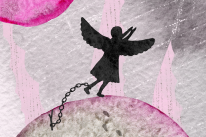![]()
When I was in fourth grade, a girl from another class bullied me. I was in the bathroom during class when I heard the door creak open and whooshing shut. There was silence for a moment, then the girl’s hands appeared on the top of the stall door, followed by her face.
“Whaddaya doin’ in there?” she asked.
I quickly covered myself and replied as nicely as I could, “I’m using the bathroom.”
“Well, hurry up,” she said. “Because I want to go.” There were three other stalls, so I knew I was in trouble.
I had no idea who this girl was. I’d seen her on the playground, but I didn’t know her name, and to this day I still have no idea why she wanted to antagonize me.
I finished my business and thought about just waiting to go out until someone else came in, but she was banging things around, and I didn’t want to be trapped in the stall if she decided to crawl under the door. So I walked out.
The first thing she did was grab my glasses off my face and throw them against the wall. I ran over to them, afraid they were broken. I knew I’d get in trouble at home if they were.
I picked them up, and as I turned around, she slapped me hard. I fell back against the wall, not even knowing how to defend myself in a fight, but I was lucky. She turned, and with her nose in the air, flounced out of the bathroom.
I carried the fear from that experience, and others, for many years. After growing up in a very dysfunctional family, I had no idea how to express all the feelings that tumbled around inside and threatened to engulf me.
When I was in my thirties, I began reading books like The Drama of the Gifted Child and For Your Own Good, and I finally began letting go of thirty years’ worth of repressed emotions.
Over the last two decades, I’ve distilled the process of letting go of old emotions into four simple steps.
Even though it’s simple, the process is not necessarily easy because it can be painful to look at old memories and hurt feelings that have been with us for many years, or even a lifetime.
But clearing out the “emotional storehouse” opens the mind to more possibilities, restores self-esteem, and leads to a rediscovery of the authentic self, which has been trapped underneath all the repressed feelings.
Here are the four steps:
1. Figure out and acknowledge what you’re feeling.
Is it shame? Sadness? Despair? Anger?
2. Find a private place, and let yourself express that feeling.
Cry, punch sofa pillows, shake your fists, throw rocks into a pond—whatever helps.
Let your body do whatever it wants to do. You can also journal, but the feelings move out faster if they’re physically expressed, because emotions are stored in the musculature of the body when they can’t be expressed.
3. Tell yourself you can let go of that feeling.
You don’t have to keep holding it inside. Call up the witness part of you to comfort yourself as you express your emotions, and remind yourself that what you’re feeling is not who you are; it’s only a feeling that will pass.
If you feel like you can’t let go of the feeling, ask yourself, “Why? What do I need to look at? What is holding me back from letting go?” A past event or experience will often surface if you ask with a feeling of curiosity and let yourself be open to any answer that comes. You may need to go back to Step 2 if this is the case.
Repeating this step over the course of several days gives your subconscious mind time to bring the issue to the surface, and you may find that it’s easier to let go of it piece by piece instead of all in one fell swoop.
If you’ve experienced a deep betrayal of yourself at some time in your life, your processing time may be longer than someone who hasn’t had many traumatic experiences. Be sure to be compassionate with yourself as you go through the process.
4. Help yourself remember that life can be good.
After you’ve let go of some feelings, call a supportive friend to talk about something else, go to a movie, or join a group that’s going to a fun place. Anything you enjoy doing is fine.
When someone hurts us, it’s human nature to hold on to the hurt because we think that somehow, if we can figure it out, it won’t be as painful. But you hurt yourself all over again when you hold on to a bad feeling—thinking about past experiences can drag you down and make you miserable over time.
It feels much better to let them go; just let their energy drift out of your body and mind. Once you do, you can see everything a little more clearly and be a little more in touch with your authentic self.
Of course, it’s always prudent to seek help if your emotions seem too overwhelming or if you find that they prevent you from functioning in life.
But if you continue this process over a period of time, eventually the old feelings will become a memory rather than a shadow that lives with you day in and day out, and you’ll be living more from your authentic self than from your past experiences.
Photo by Frank Kovalchek
About Katherine Mayfield
Katherine Mayfield is the award-winning author of a memoir about recovering from emotional abuse in her family, The Box of Daughter: Healing the Authentic Self. She’s also written several books on dysfunctional families, including Stand Your Ground: How to Cope with a Dysfunctional Family and Recover from Trauma. She blogs on dysfunctional families on her website, www.TheBoxofDaughter.com. Twitter: @K_Mayfield













 Though I run this site, it is not mine. It's ours. It's not about me. It's about us. Your stories and your wisdom are just as meaningful as mine.
Though I run this site, it is not mine. It's ours. It's not about me. It's about us. Your stories and your wisdom are just as meaningful as mine. 